“Candi Mendut is a reflection of the sublime and stupendous “Indrajal” of the Javanese people when they attained unprecedented heights of power, when literary genius blossomed in their language of Javanese, when they enriched their lovely island with monumental structures that evoke wonder after twelve centuries, even in their ruined state.”
“Even now it is still a mystery why the three temples are connected in a straight line? It is very possible that this has a purpose, for example associated with astrology or others. Another question is how to determine the location of the temples in the past? What technology was used at that time? The positions of Candii Borobudur, Candi Pawon and Candi Mendut are in this line following the constellation Orion Alnitak, Alnilam, Mintaka (Orion Belt).” — Uday Dokras (2023)
Vesak/Buddha Purnima/Saga Dawa Day (the full moon of the fourth lunar month), which commemorates the Shakyamuni Buddha’s birth, enlightenment and parinirvana, celebrated this year on 22 May (Thailand and Cambodia) and 23rd May (India, Tibet, Indonesia) is a national public holiday, when the selling of alcohol and meat are even forbidden in some places. In Indonesia, on this important Buddhist day, monastics walk all the way from Semerang to Borobudur temple (called the Bikkhu Thudong) and during their walk they also visit another ancient 9th Century temple, in the Java area called Mendut (Venuvana).
Thus, in the spirit of Vesak/Saga Dawa, and continuing with the Indonesia pilgrimage trip topic, this article shares some information about the ancient Mendut temple, next to which is the stunning (and more recently built) Mendut Buddhist monastery. Mendut, Borobudur, and Pawon temples are located in one straight line in the Borobudur area. There is a mutual religious relationship between the three temples, although the exact ritual process is unknown. On Vesak Day, there is also procession from these temples to Borobudur at which a large prayer festival will be held (see photo below), also see reel of monastics visiting Mendut temple today here. The ritual takes the form of mass Buddhist prayer and pradakshina, or circumambulation, around the temple. For local Javanese, especially those who follow traditional Kejawen Javanese mysticism or Buddhist practices, praying in Mendut temple is believed to fulfill a variety of desires, especially being healed from sickness.
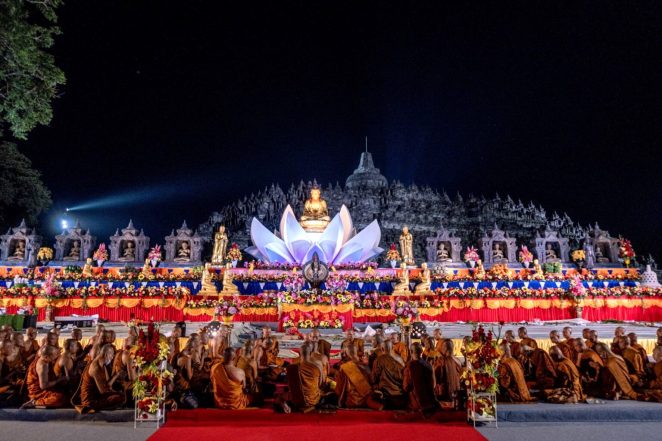
In Demystifying Mendut, by Dr. Uday Dokras(2023) explains:
“Mendut Temple also becomes the staging point for the annual ritual ceremony of Vesak, where the holy waters from the pristine springs of Jumprit and the torch with the natural eternal flames at Mrapen are kept, before the monks and congregations conduct their ritual procession from Mendut to Borobudur.”
This article, first gives some historical background on the Mendut temple, its name and origin, followed by some personal observations and photos of my visit there. Considered to be a jewel of Javanese Buddhist culture, the temple is easy to get to by car (or even on foot) from Borobudur temple, around 3.5km east. Although, it may look insignificant compared with its famous and bigger neighbour, it is said to be older and has stunning art wall murals, but also houses three of the most outstanding original Buddhist statues, Buddha Vairocana, Avaloketishvara and Vajrapani in their original setting of any temple in Java.
Wishing all a happy and meaningful Vesak/Saga Dawa Day, when we remember the remarkable birth, life and nirvana of Buddha Shakyamuni. For more on the the Buddha’s mother (who is often overlooked) and the birth of Buddha, see article here.
Music? Indonesian Buddhist chanting by women at the Sakyadita Conference 2015 in Yogyakarta, Shakyamuni Buddha praise in Tibetan (with English subtitles) and Buddha Mantra, OM MUNI MUNI MAHA MUNIYE SVAHA.
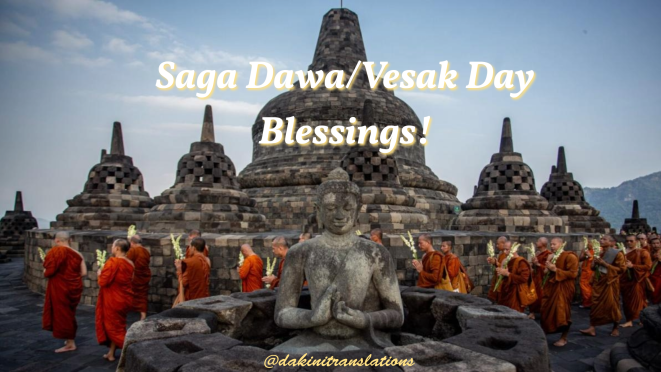
Indrajal: The Jewel of Java, Mendut temple
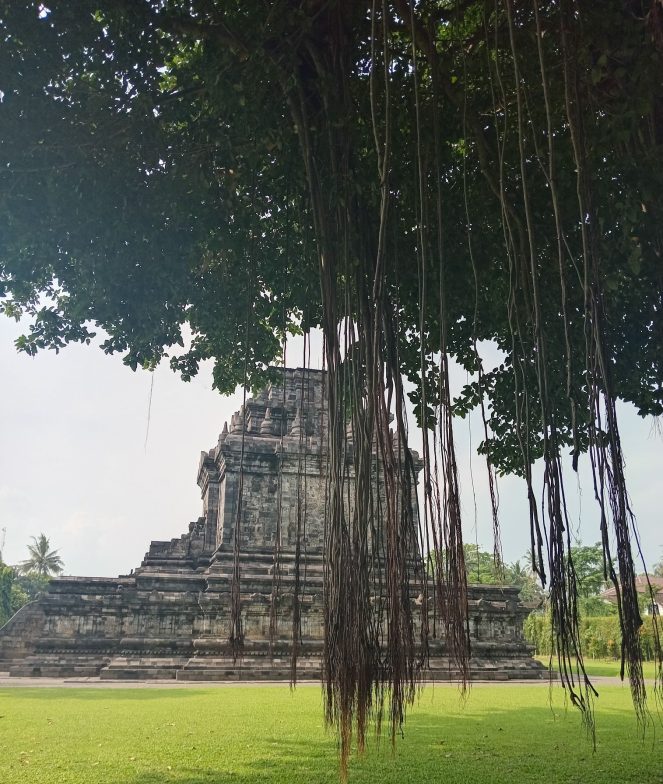
According to a recent paper, Demystifying Mendut, by Dr. Uday Dokras (2023):
“Candi Mendut is a reflection of the sublime and stupendous “Indrajal” of the Javanese people when they attained unprecedented heights of power, when literary genius blossomed in their language of Javanese, when they enriched their lovely island with monumental structures that evoke wonder after twelve centuries, even in their ruined state. Indrajal means the Net of Indra the creator of the Universe and is a book consisting of tantra and mantra to supernatural power. The word is used to refer to supernatural creations that cannot be explained except by imputing the creation to God Indra. The Candis can be understood as cosmic symbols of sovereignty that encode astronomical perceptions of the auspicious.
Often overlooked because of its close proximity to the world famous Borobudur, Candi Mendut was widely regarded by the early Dutch scholars as ranking among the most shining architectural jewels produced by the remarkable civilization that emerged in Central Java during the eight century. In his book Candi Mendut – Womb of the Tathagata, Mark Long describes it thus:
“The division of the walls beneath the first cornice by means of horizontal and vertical lines and of the balustrade wall, is so masterful, the effect so starling, and the whole so little overloads the eye – on the contrary, being almost soberly treated – that one may classify the Mendut temple without hesitation among the most successful monuments of the Hindu era.”

“Mendut, Borobudur and Pawon, all of which are Buddhist temples, are located in one straight line. There is a mutual religious relationship between the three temples, although the exact ritual process is unknown. Until now, it is not clear when Mendut Temple was built.
A historian J.G. de Casparis estimates that Mendut Temple was built by the first king of the Syailendra dynasty in 824 AD. So Mendut Temple is thought to be the first temple built by Wangsa Syailendra. J.G. de Casparis also estimates that Mendut Temple is older than the age of Borobudhur Temple. This historian’s estimate is based on the Karangtengah inscription (824 AD) which states in the inscription that King Indra had made a sacred building called Venuwana”
“The temple is on a north to south straight line with the Borobudur and Pawon Temples. Local legend relates that long ago a brick-paved road led from Mendut to Borobudur, closed in by walls with niches built into them. According to Dutch archaeologist JG de Casparis, the temple forms part of a once huge temple complex together with the Pawon and Borobudur temples and, chronologically speaking, is the oldest among the three.”
The Sailendra Dynasty in Java
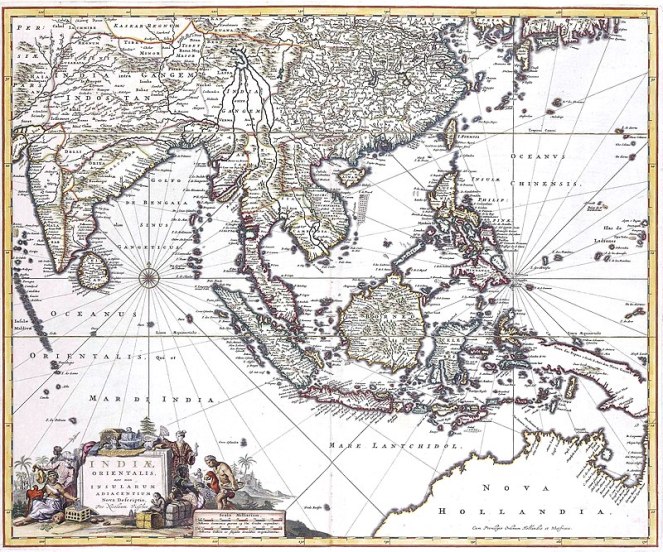
The Shailendra dynasty (Śailēndra, Indonesian pronunciation: derived from Sanskrit combined words Śaila and Indra, meaning “King of the Mountain”) was the name of a notable Indianised dynasty that emerged in 8th-century Java, whose reign signified a cultural renaissance in the region. The Shailendras were active promoters of Mahayana Buddhism and covered the Kedu Plain of Central Java with Buddhist monuments, one of which is the huge stupa of Borobudur, now a UNESCO World Heritage Site (see my article about Borobudur here).
The inscriptions created by Shailendras use three languages; Old Javanese, Old Malay, and Sanskrit — written either in the Kawi alphabet, or pre-Nāgarī script. The use of Old Malay has sparked speculation of a Sumatran origin, or Srivijayan connection of this family. On the other hand, the use of Old Javanese suggests their firm political establishment on Java. The use of Sanskrit usually indicates the official nature, and/or religious significance, of the event described in any given inscription.
The Sanskrit/Javanese Inscription about Mendut temple
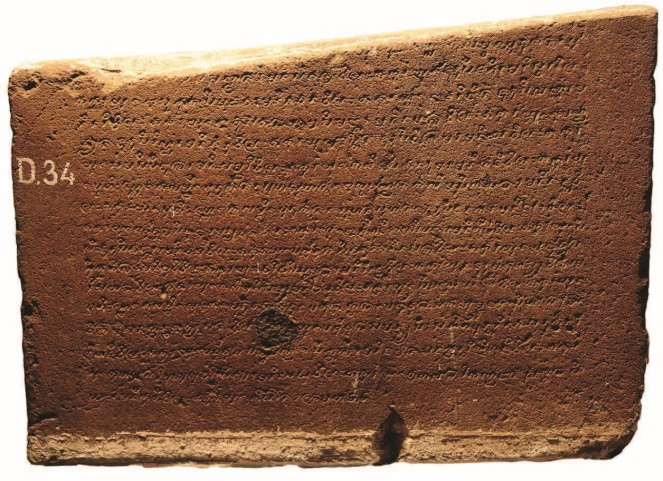
Dokras (2023) explains:
“Karangtengah inscription (also known as Kayumwungan inscription) is the inscriptions written on five pieces of stones dated 746 Saka or 824 CE, discovered in Karangtengah hamlet, Temanggung Regency, Central Java, Indonesia. The inscription was written in ancient Javanese script in two languages; Old Javanese and Sanskrit. The lines 1-24 was written in Sanskrit, the rest of the lines was written in old Javanese. The inscription is linked with the temple Borobudur and Mendut The parts written in Sanskrit mentioned about a king named Samaratungga. His daughter named Pramodhawardhani has inaugurated a Jinalaya (Sanskrit meaning:Jain temple and the realm of those have conquer worldly desire and reach enlightenment called jina which is also a common epithet of the Buddha which is most likely the intended meaning here ), a sacred Jina sanctuary.
The inscription also mentioned a sacred buddhist building called Venuvana (Sanskrit: bamboo forest) to place the cremated ashes of ‘king of the cloud’, the name for god Indra, probably referred to King Indra of Sailendra dynasty. Jinalaya was identified as Borobudur.
Venuvana was identified as Mendut temple by Dutch archaeologist JG de Casparis, while Soekmono identified it with Ngawen temple instead. In the parts written in old Javanese, mentioned about an event, that in the 10th day of Kresnapaksa in the month of Jyestha year 746 Saka (824 CE), Rakai Patapan pu Palar inaugurated that rice fields in Kayumwungan to be the tax free land protected by royal edict. Rakai Patapan pu Palar is identified as Rakai Garung, the king of Mataram Kingdom. Indonesian historian Slamet Muljana suggest Rakai Garung was another name of Samaratungga”.
The outer temple
In terms of the construction Mendut temple:
“The internal structure of this Buddhist temple is made of bricks, but the outer walls are made of and esite stone. This building has a basement, above which there are alleys that surround the temple. Around Mendut Temple, there are 48 small stupas.”
The Dutch are said to have discovered this sacred structure by chance in 1836, while cutting through thick foliage to clear the plot for a coffee plantation. After careful inspection, overseen by Theodore Van Erp, the ruins were eventually uncovered. The restoration of this temple was started in 1897 and was finished in 1925.

Mendut Temple’s architecture reflects the traditional design of Buddhist temples in the region. A compact yet elegant structure adorned with intricate carvings and reliefs. These carvings depict scenes from Buddhist scriptures and Javanese mythology and offers insights into the spiritual beliefs and cultural practices of the time.
The plan of the 26.4 metre tall temple’s base is square, and measures 13.7 metre on each side, with the base level 3.7 metre above the ground. The stairs projecting from the northwest side square elevated base is adorned with a Makara statue on each side, the side of the stairwell is carved with bas-relief of Jataka fable narrating the animal story of Buddhist teaching. The square terrace surrounding the body of the temple was meant for pradakshina or circumambulating ritual, walking clockwise around the temple. I was able to do some circumambulation while there.
The outer walls are adorned with bas-reliefs of Boddhisattvas such as Avalokitesvara, Maitreya, Cunda, Ksitigarbha, Samantabhadra, Mahakarunika Avalokitesvara, Vajrapani, Manjusri, Akasagarbha, and Boddhisattvadevi Prajnaparamita among other Buddhist figures.


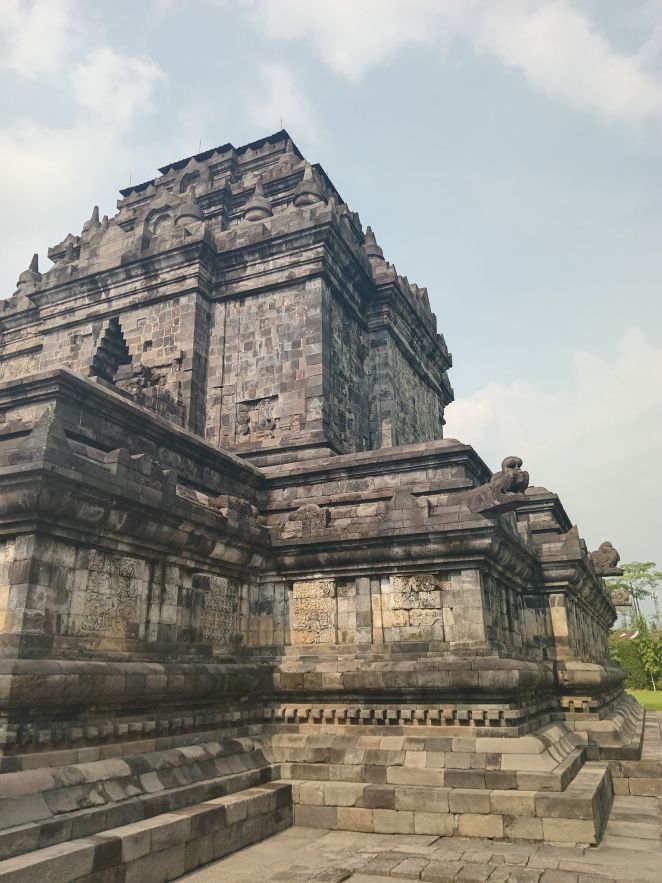

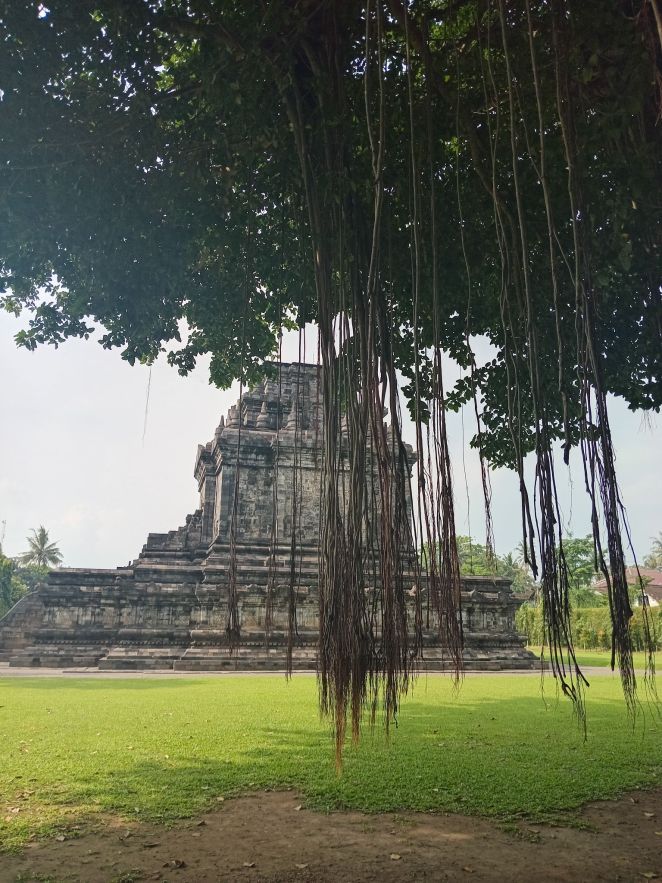
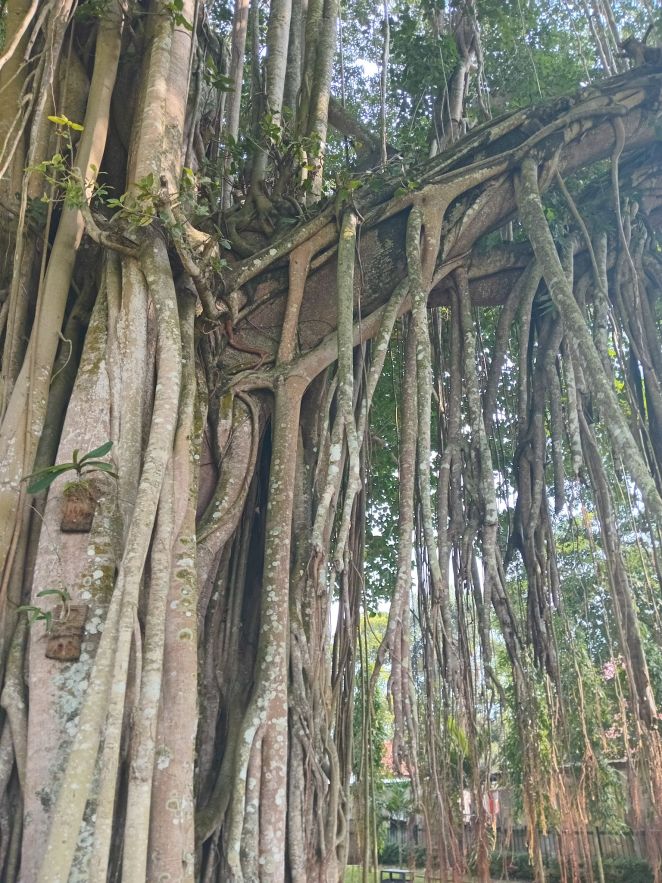
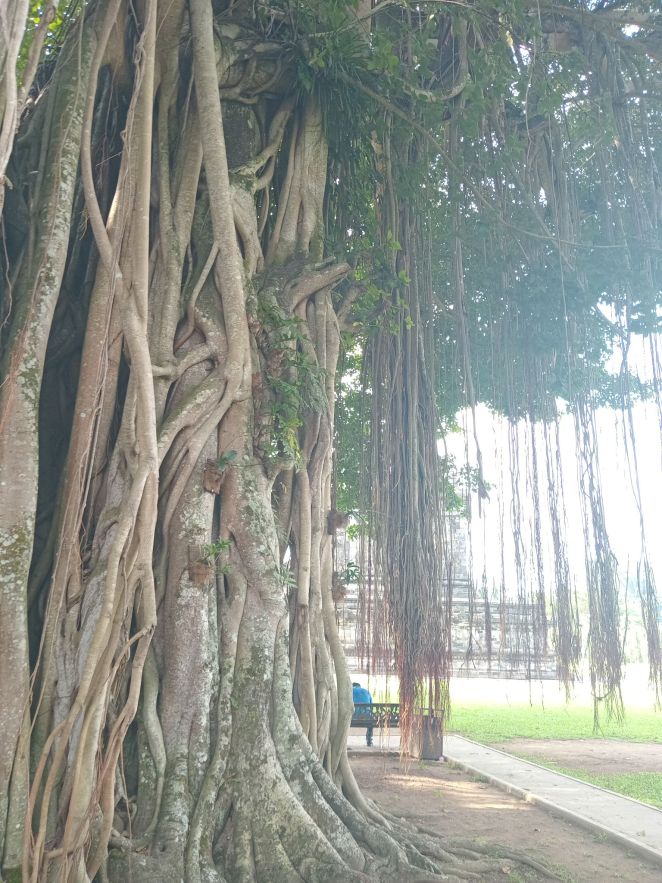

Three major Buddhist statues in their original form: wisdom, compassion and power
Entering the temple after going up the staircase to it, one sees three remarkably well-preserved carved stone statues. The formidable central figure is the Buddha Vairocana, depicted in a seated position, with both feet touching the ground. His hands are in Dharmachakra mudra, a gesture used by Buddha during his first sermon after enlightenment, representing the continuous flow of energy.
To the left of Vairocana is a statue of Boddhisatva Avalokitesvara representing mercy and compassion, and at the right is Boddhisattva Vajrapani representing power and enlightened energy.

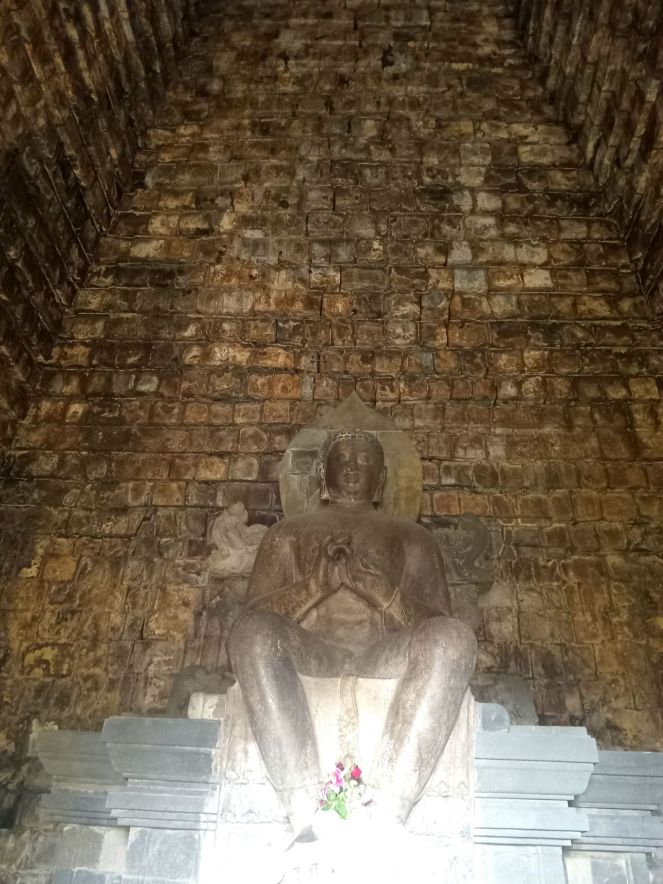

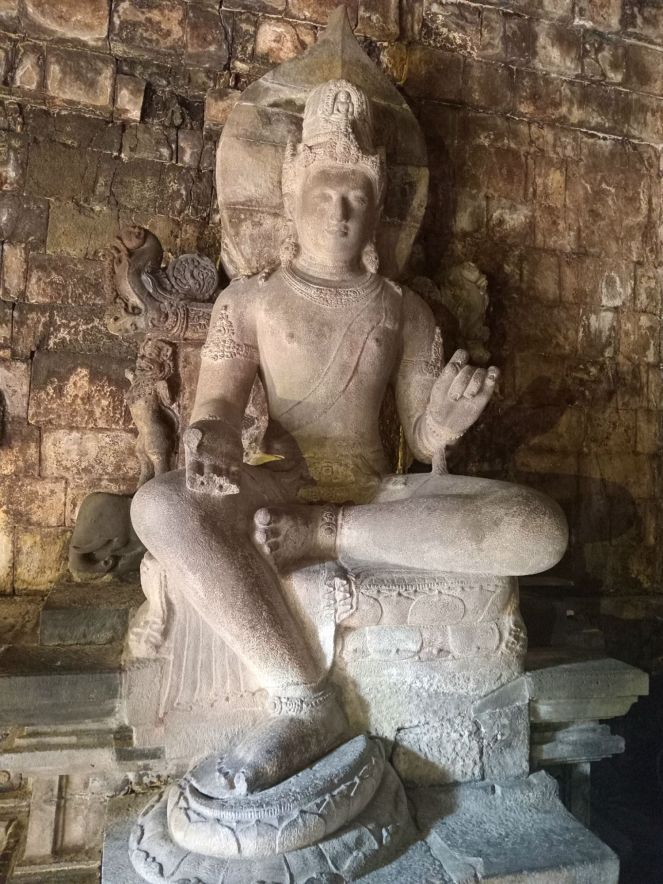
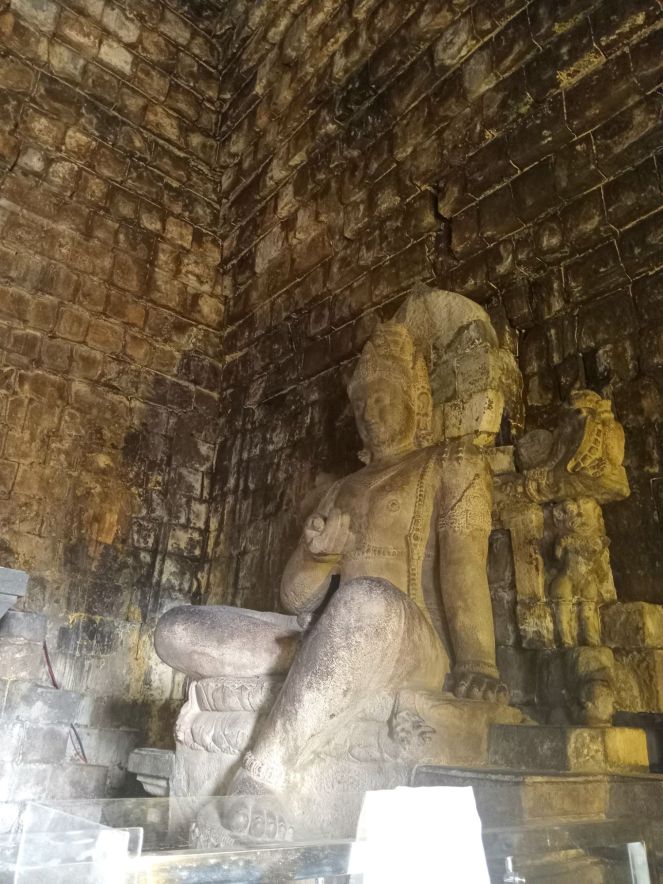
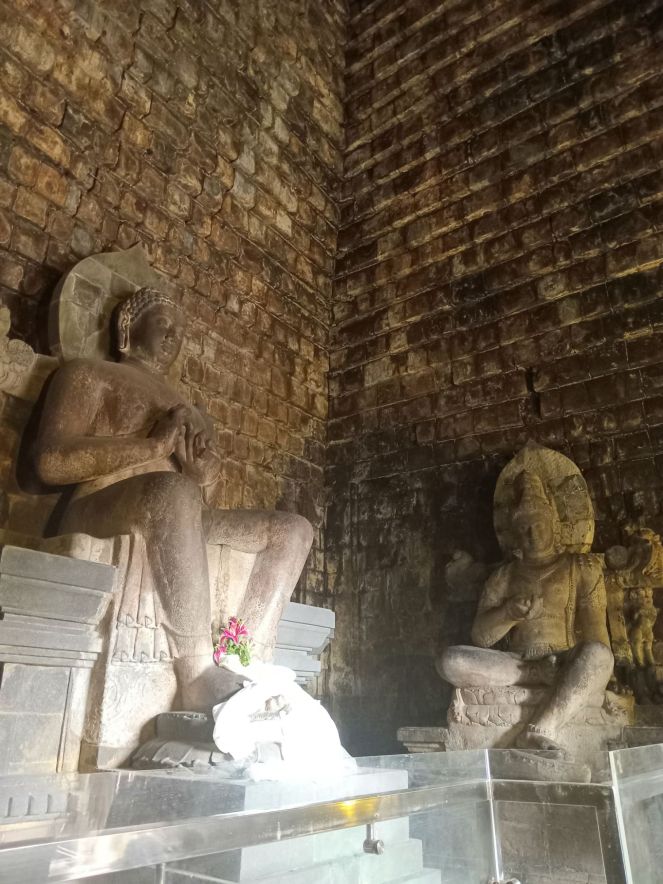
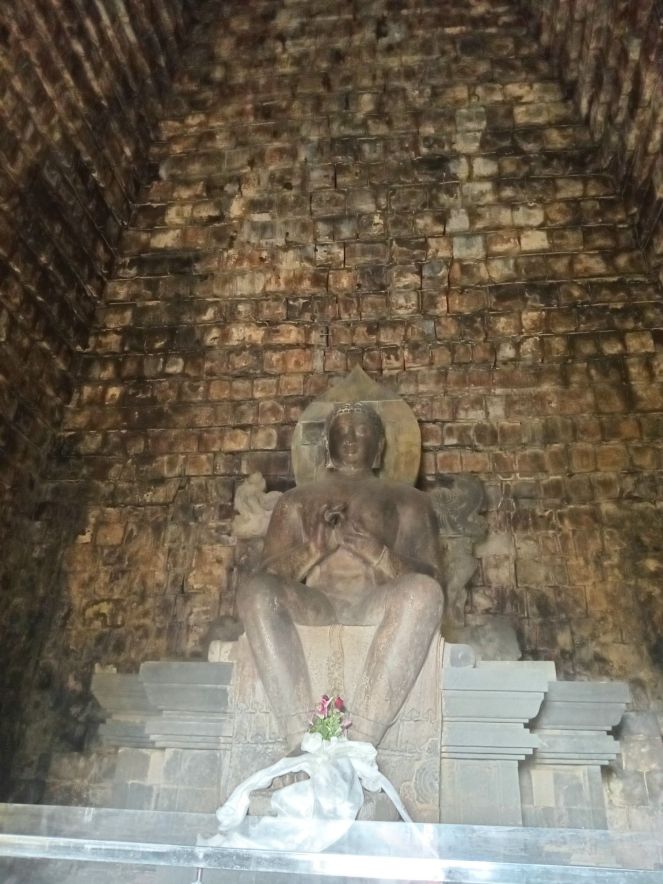

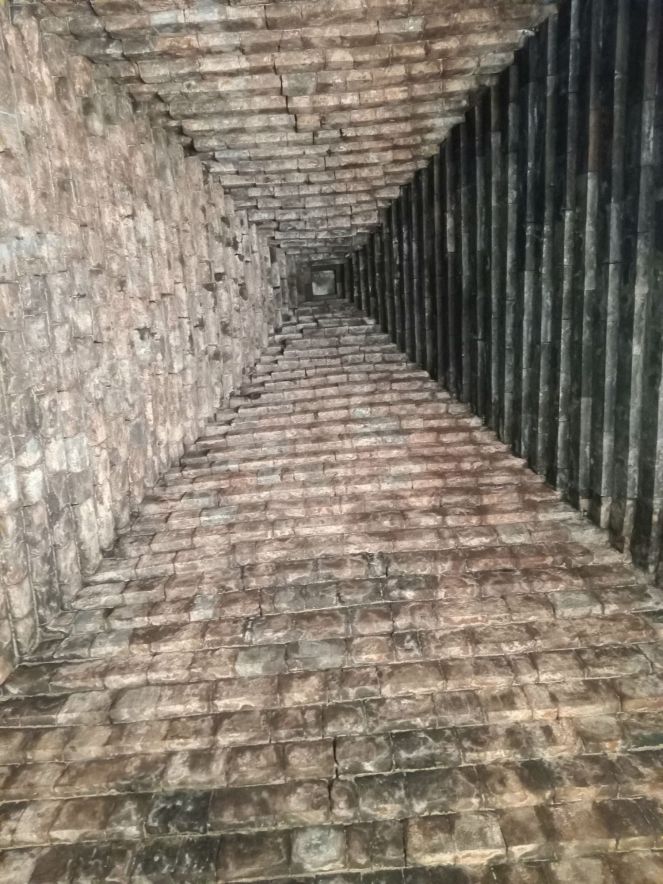
The Bamboo Forest temple (Mendut)

Bamboo is an indigenous plant/tree in Java, Bali and the Indonesian region. Recently, climate change and environmental initiatives for renewable power and to save energy, have been launched using the Bamboo tree in Indonesia. In his paper Dr. Dokras (2023) explains the translation of the name Venuvana as ‘bamboo forest’:
- Veṇu (वेणु) refers to “bamboo” and represents one of the seven forest-products that are fit for oblation according to verse 25.59 of the Īśvarasaṃhitā, dealing with the classification of the places for building the fire-pits (kuṇḍa). Accordingly, “bamboo (veṇu), śyāmāka, nīvāra(wild gram), jartila, gavīdhuka, karkaṭa and kanaka are the seven which grow in the forest. Śāli is important among them. Others are to be taken in its absence, or that of others”.
- Van is the name for Forest in 27 Indic languages and is also derived from Sanskrit. Apparently there was a bamboo forest in the vicinity of Mendhut and Venu vana means Forest of Bamboo but also refers to the dwelling place of Shiva.
Dokras (2023) also gives detail of why the bamboo is so spiritually and ecologically significant [1].
The straight line of the Java temples and the astrological connection of Orion
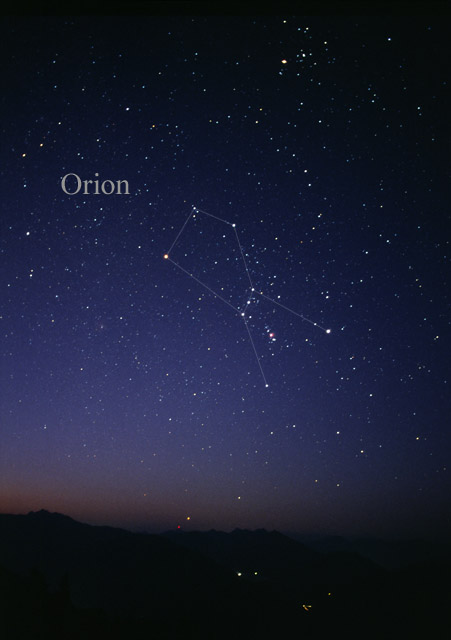
Dokras (2023) also considers the astrological import of the temples’ location and the stellar constellation of Orion. Although Dokras does not refer to these in his paper, in China, Orion was one of the 28 lunar mansions Sieu (Xiù) (宿). It is known as Shen (參), literally meaning “three”, for the stars of Orion’s Belt. In India, The Rigveda refers to the Orion Constellation as Mriga (The Deer). In medieval Muslim astronomy, Orion was known as al-jabbar, “the giant”. Orion’s sixth brightest star, Saiph, is named from the Arabic, saif al-jabbar, meaning “sword of the giant”. Dokras (2023) explains:
“Even now it is still a mystery why the three temples are connected in a straight line? It is very possible that this has a purpose, for example associated with astrology or others. Another question is how to determine the location of the temples in the past? What technology was used at that time? The positions of Candii Borobudur, Candi Pawon and Candi Mendut are in this line following the constellation Orion Alnitak, Alnilam, Mintaka (Orion Belt)….How did in the past understand the relationship between the three temples and the constellation Orion? Why do the three temples stand in the same slanted line as the constellation Orion?”
Newer neighour: Mendut Buddhist Monastery
Next to the ancient Mendut temple is the leafy and serene Mendut Buddhist Monastery, studded with palms and clumps of golden bamboo. Guests can join group meditations there at 7pm daily and also stay for meditation retreats. While there it was very peaceful and calm, although I did not see any Buddhist monastics.
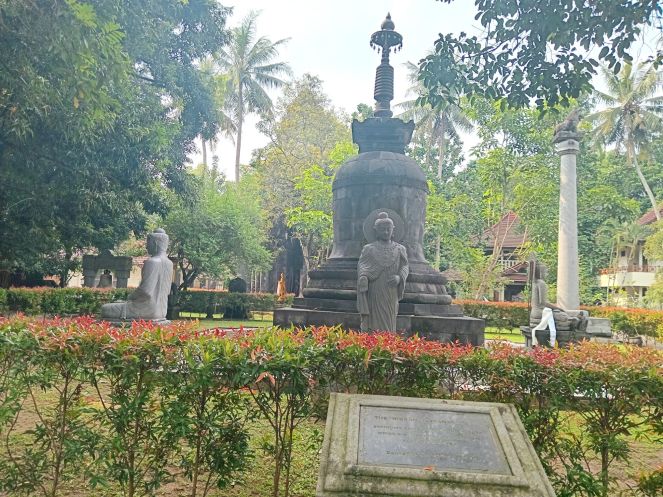
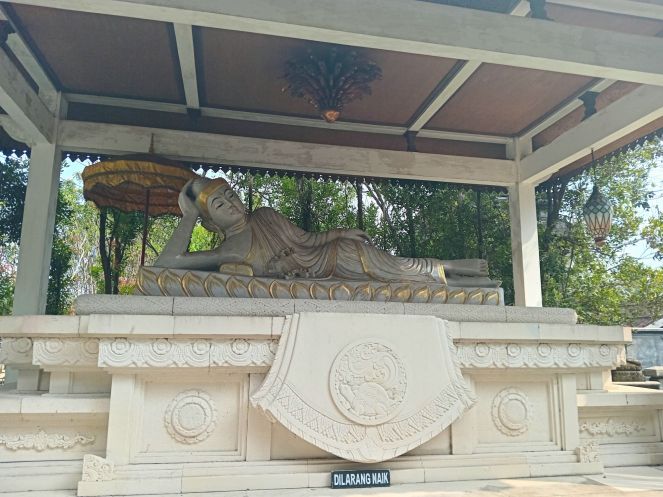
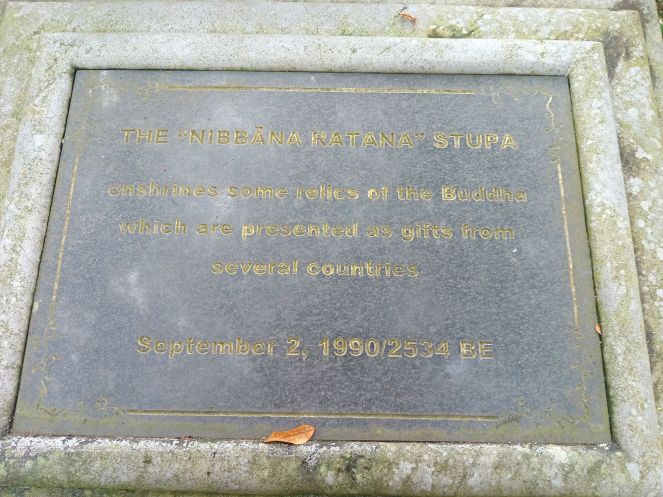
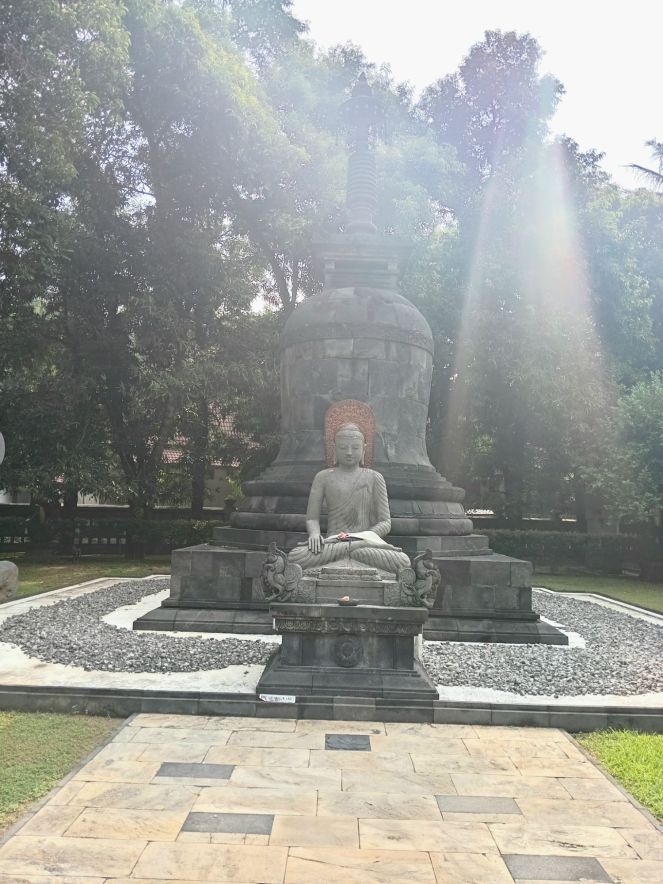

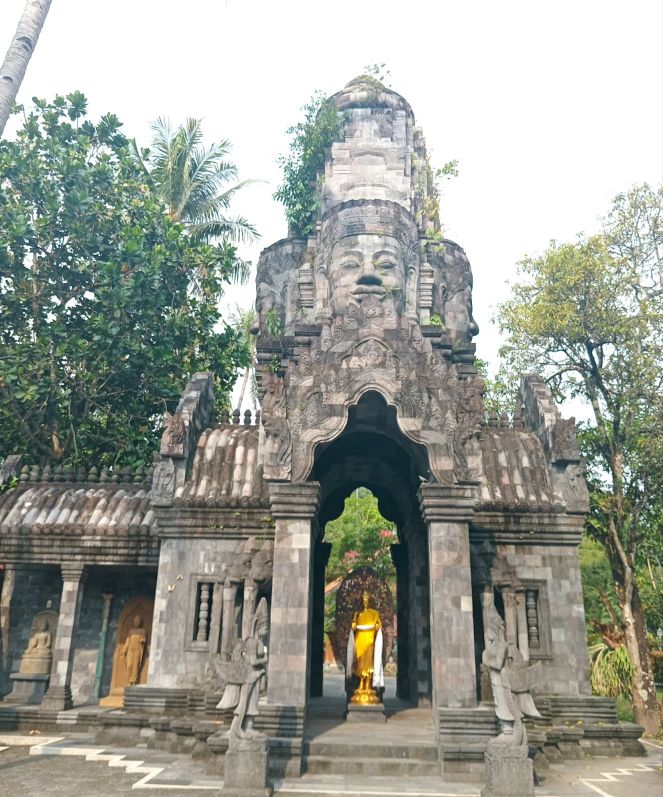
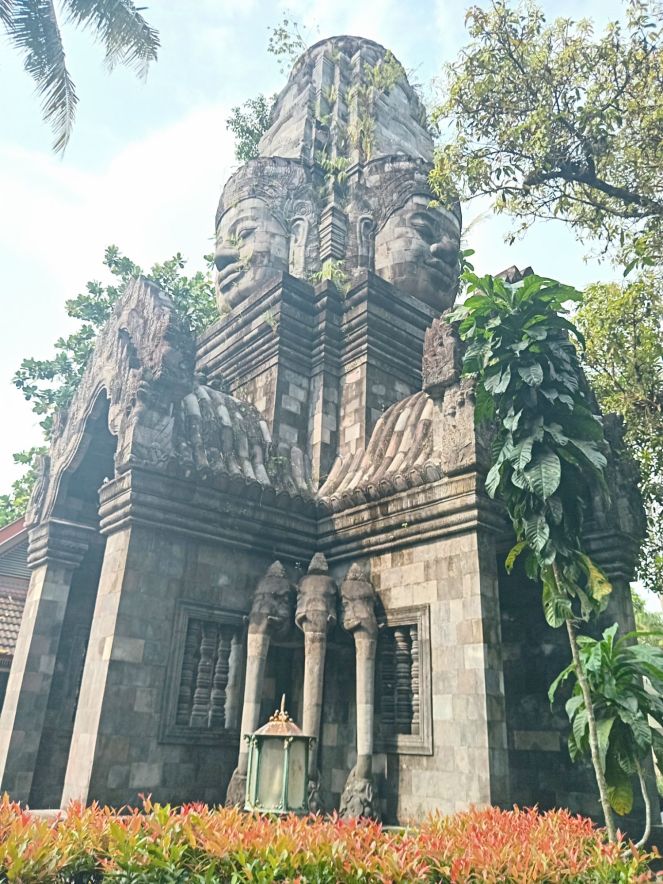
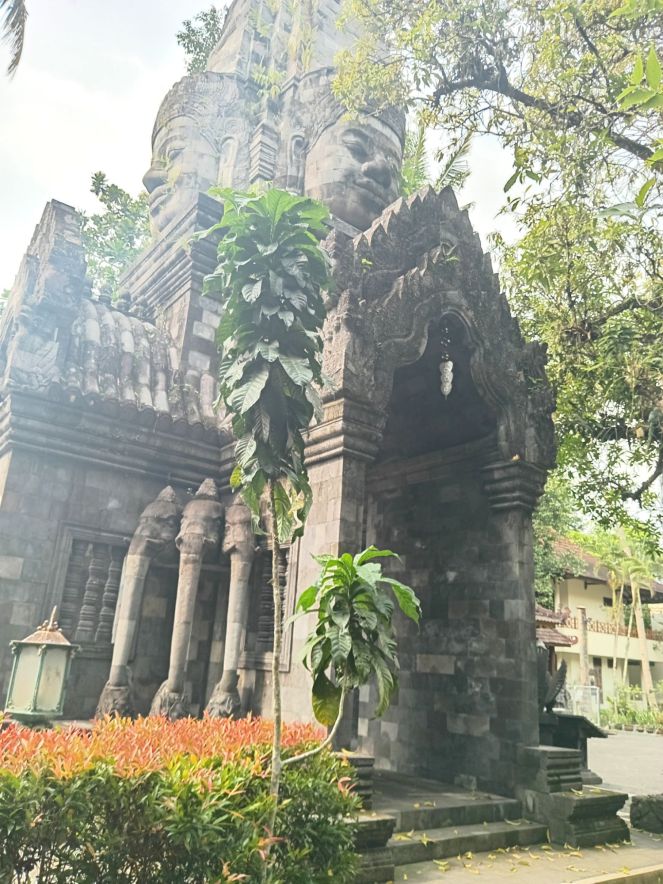
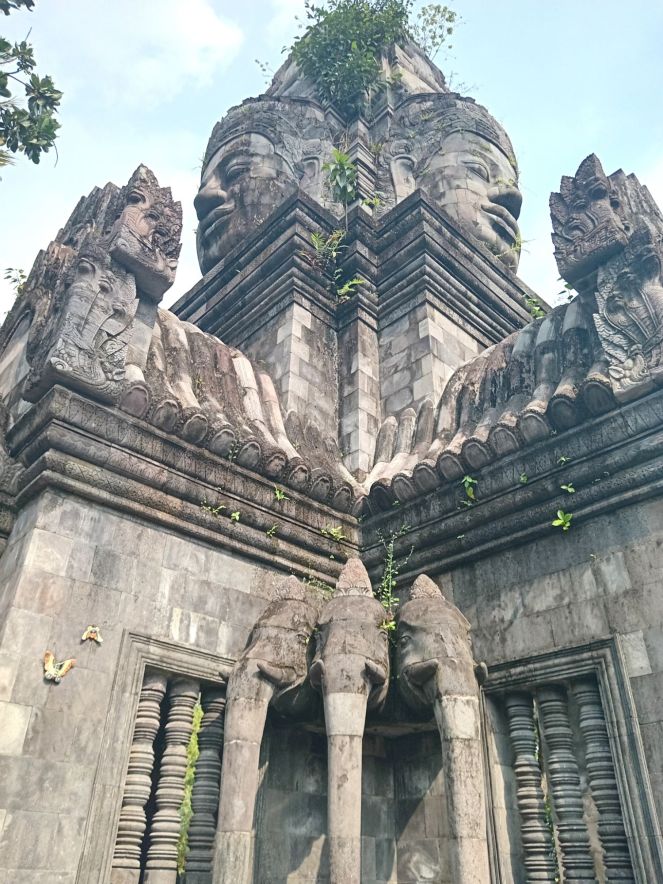
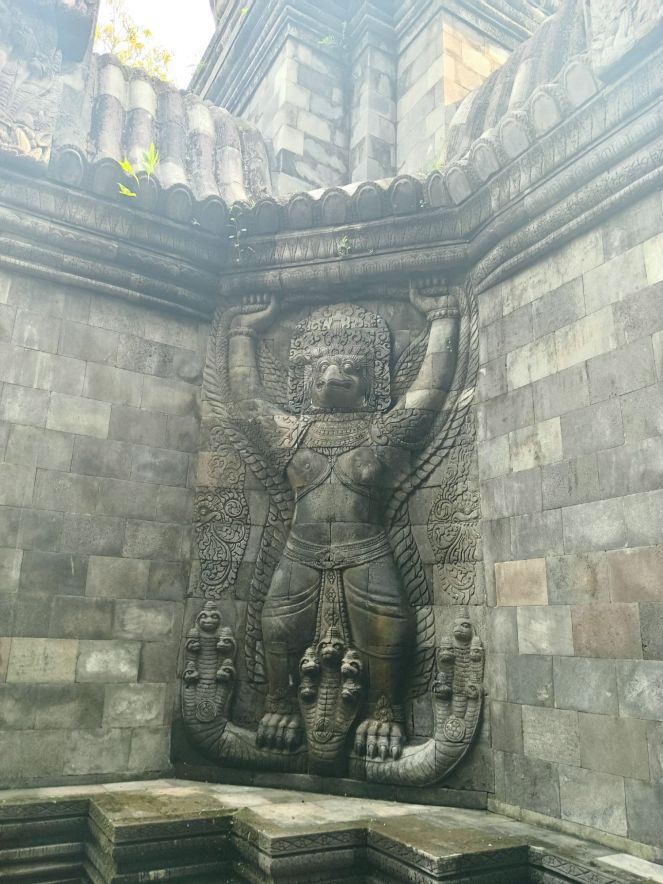

Endnotes
[1] Dokras (2023) explains the significance of bamboo:
- Bamboo grows in clusters, so it is regarded as symbolic of a large family and prolific progeny. However, only the green bamboo is regarded as sacred. The dry one is deprived of all sanctity.
- The bamboo is sacred to both Shiva and Vishnu. It is an emblem of Venugopala or Krishna. It is also sacred to Buddhists and has been depicted in the bas-reliefs of stupas and in Buddhist sculpture.
- The Ramayana calls it a common forest tree (6.12.56) found growing on the banks of the Yamuna (2.55.8), and says that dried bamboo is used to make rafts to cross the river (2.55.14). It is used to make pillars and rafters in cottage construction (3.1.21). It is also used as a pillar of the straw cottage constructed by Lakshmana (3.15.21-23).
- The Mahabharata (1.63) mentions the festival of the bamboo pole, which involved planting a bamboo pole every year in honour of Indra. After erecting the pole, people decorated it with golden cloth, perfumes, garlands, and ornaments. Then the ruler, Uparichara Vasu, the king of Chedi who belonged to the Puru Dynasty, prayed for the expansion of his cities and kingdom.
- In north India, the green bamboo and its branches are used to make the canopy under which wedding ceremonies are performed. Coffins are also made of green bamboos.
- During the sacred-thread ceremony, a twig of the bamboo is given to the boy.
- People of the Turi tribe of Gujarat place two small pieces of bamboo in the room of confinement, so that no malicious spirit can influence the newborn.
- In Bihar and Uttar Pradesh, newly married couples place their feet in a bamboo basket and walk slowly, so that they do not fall flat on the ground. It is very auspicious to walk in this manner because it is symbolic of a large family. The Prabhus of Pune place bamboo baskets on the heads of the bride and the bridegroom. The Mubasis of Bengal ask married couples to go around a bamboo post. The Garos and Kacharis of Assam worship the bamboo post after planting it in the ground.
- On the other hand, it is widely believed in Uttar Pradesh that a churail (evil female spirit) lives in bamboo groves (Upadhyay 1964, 24).
- During the aghora puja, after worshipping Shiva and Parvati, the performance of homa, followed by feeding of Brahmanas and young girls, takes place. On this day, a branch of the bamboo is planted on one side of the pandal, along with mango flowers and a banana tree with flowers, and they are worshipped by all.

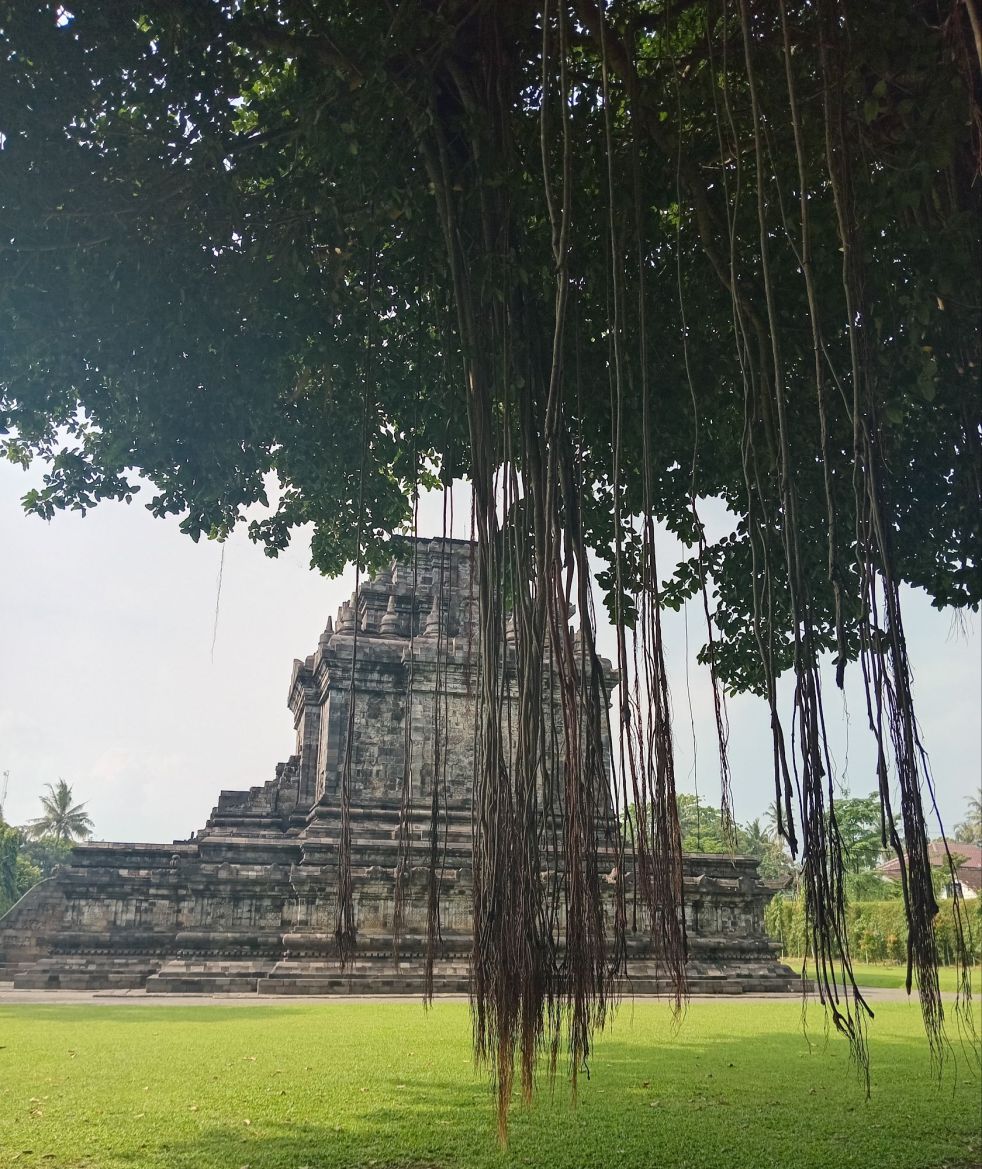
Dear Adele, I am so enjoying your travels and blog posts especially the recent ones in Java. I have had dreams of that lake and the lotus there. So evocative and seeping into my practices. I really think you are on to something with this Oddiyana connection. Thank you so much! I also listen to your podcast which I greatly enjoy. For the Benefit of All, Melissa Shubha Abbott
Thanks Melissa for your inspiring words and kind support 🙂 Happy to hear you also find the Oddiyana research interesting and enjoy the podcasts too! Love and good wishes, Adele